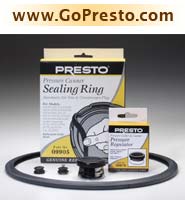The first acknowledged attempt at pressure cooking occurred in 1679 when
French physicist, Denis Papin, who is most noted for his work with steam
power, invented the “Steam Digester” in an effort to reduce the time needed to cook foods. This airtight cooking
vessel used internal steam pressure to increase the boiling point of water,
and as a consequence cooked foods faster. Over a hundred years after Papin’s
discovery, in 1795, the French government offered a reward of 12,000 francs
for anyone who could develop a method of preserving food supplies for the
French armed forces. French confectioner Nicolas Appert took on the challenge
and developed a canning process
in an effort to reduce the time needed to cook foods. This airtight cooking
vessel used internal steam pressure to increase the boiling point of water,
and as a consequence cooked foods faster. Over a hundred years after Papin’s
discovery, in 1795, the French government offered a reward of 12,000 francs
for anyone who could develop a method of preserving food supplies for the
French armed forces. French confectioner Nicolas Appert took on the challenge
and developed a canning process  of
packing food in clean jars sealed with a cork and cooking them in boiling
water. This preservation method was accepted, and in 1809, Emperor Napoleon
Bonaparte awarded Appert the prize money for inventing this basic canning
process. Nicolas Appert then used his jackpot to open “The House
of Appert,” the first commercial cannery in the world. These early
discoveries, although crude, helped to develop the science of pressure
cooking that we
know today. Although pressure canning and pressure cooking are different
methods, their history is so intertwined that you cannot have one without
the other.
of
packing food in clean jars sealed with a cork and cooking them in boiling
water. This preservation method was accepted, and in 1809, Emperor Napoleon
Bonaparte awarded Appert the prize money for inventing this basic canning
process. Nicolas Appert then used his jackpot to open “The House
of Appert,” the first commercial cannery in the world. These early
discoveries, although crude, helped to develop the science of pressure
cooking that we
know today. Although pressure canning and pressure cooking are different
methods, their history is so intertwined that you cannot have one without
the other.
By the early twentieth century, the pressure canning process had advanced,
and in the United States, National 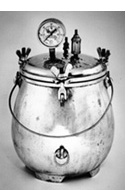 Presto
Industries (then known as Northwestern Steel and Iron Works) had become
a major producer of 50-gallon industrial-size “canner retorts”.
The hotel and institutions industry requested a 30-gallon
size, and later
a 10-gallon size was developed for home use. By 1917, the United States
Department of Agriculture determined that pressure canning was the only
safe method of preserving low-acid foods without risk of food poisoning.
In kitchens across the country, homemakers were quickly discovering the
many “dinnertime” benefits of high speed cooking in their pressure
canners.
Presto
Industries (then known as Northwestern Steel and Iron Works) had become
a major producer of 50-gallon industrial-size “canner retorts”.
The hotel and institutions industry requested a 30-gallon
size, and later
a 10-gallon size was developed for home use. By 1917, the United States
Department of Agriculture determined that pressure canning was the only
safe method of preserving low-acid foods without risk of food poisoning.
In kitchens across the country, homemakers were quickly discovering the
many “dinnertime” benefits of high speed cooking in their pressure
canners.
Home pressure cooking, however, took a major step forward in 1938 when German
Alfred Vischler introduced his “Flex-Seal Speed Cooker,” the
first “saucepan-style” pressure cooker, at a New York City Trade
Show. Although Vischler’s idea was on target, the product that caught
the attention of homemakers was the “Presto” 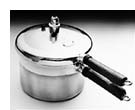 pressure
cooker, unveiled at the 1939 New York World’s Fair. Women were thrilled
with this modern saucepan-style pressure cooker because it featured an easy-to-close
interlocking cover, eliminating the need for awkward lug nuts and clamps.
In the United States, “Presto” soon became the name synonymous
with pressure cooking. The depression was over and stores could not keep
up with the demand for them. By the end of 1941, pressure cookers ranked
among the largest producers of housewares dollar volume in leading stores
throughout the country. At that time, there were 11 companies manufacturing
pressure cookers.
pressure
cooker, unveiled at the 1939 New York World’s Fair. Women were thrilled
with this modern saucepan-style pressure cooker because it featured an easy-to-close
interlocking cover, eliminating the need for awkward lug nuts and clamps.
In the United States, “Presto” soon became the name synonymous
with pressure cooking. The depression was over and stores could not keep
up with the demand for them. By the end of 1941, pressure cookers ranked
among the largest producers of housewares dollar volume in leading stores
throughout the country. At that time, there were 11 companies manufacturing
pressure cookers.
Then, Pearl Harbor was bombed. World War II brought a temporary end to
the manufacture of pressure cookers because aluminum was needed for the
war
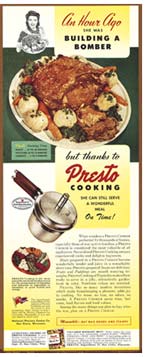 effort. Food and fuel were being rationed along with many other necessities.
The War Production Board made steel available for use in manufacturing
Pressure
Canners for the important victory garden and canning programs. Women were
marching off to work in the defense plants and the pressure cooker was
gaining
more recognition because it made meal planning much easier. Sadly, there
weren’t enough pressure cookers to go around, so neighbors and friends
began sharing their cookers to get by until the war was over. The pent up
demand for pressure cookers was tremendous at the close of the war. Up to
50 or more new manufacturers were trying to cash in on this cooking sensation,
many were producing cheap, substandard cookers and selling them to unsuspecting
consumers.
effort. Food and fuel were being rationed along with many other necessities.
The War Production Board made steel available for use in manufacturing
Pressure
Canners for the important victory garden and canning programs. Women were
marching off to work in the defense plants and the pressure cooker was
gaining
more recognition because it made meal planning much easier. Sadly, there
weren’t enough pressure cookers to go around, so neighbors and friends
began sharing their cookers to get by until the war was over. The pent up
demand for pressure cookers was tremendous at the close of the war. Up to
50 or more new manufacturers were trying to cash in on this cooking sensation,
many were producing cheap, substandard cookers and selling them to unsuspecting
consumers.
In the 50s, the pressure cooker business moved forward with the introduction
of stamped aluminum models for the budget minded homemaker and technological
advances in the fabrication of stainless steel brought new lines of beautiful,
long lasting stainless steel pressure cookers. But, by the late 50s, the
bottom began to fall out of the pressure cooker business. The new manufacturers
that emerged into this industry with inferior products and consumers that
were using the cooker improperly were hurting the pressure cooker’s
reputation, and its popularity began to wane.
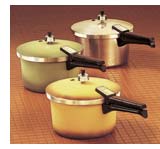 The 60s and 70s produced a multitude of new “fast food” cooking
inventions, yet cooking a quick and healthy “real meal” remained
elusive. While all this change was happening, only the reputable pressure
cooker companies remained in business, continuing to improve their products
and selling to faithful pressure cooker customers who had long understood
the benefits of pressure cooking. In the mid 70s, pressure cookers took
a key step forward with the development of additional safety features
and
new contemporary styling. An interlocking cover, that prevented the cooker
from being opened unless pressure was safely reduced, and the addition
of
secondary overpressure devices eased the consumer’s resistance to
pressure cooking. As the 80s progressed, cookbooks with new, modern recipes
were being developed and pressure cookers, once again, were beginning to
entice the interest of new consumers in the marketplace.
The 60s and 70s produced a multitude of new “fast food” cooking
inventions, yet cooking a quick and healthy “real meal” remained
elusive. While all this change was happening, only the reputable pressure
cooker companies remained in business, continuing to improve their products
and selling to faithful pressure cooker customers who had long understood
the benefits of pressure cooking. In the mid 70s, pressure cookers took
a key step forward with the development of additional safety features
and
new contemporary styling. An interlocking cover, that prevented the cooker
from being opened unless pressure was safely reduced, and the addition
of
secondary overpressure devices eased the consumer’s resistance to
pressure cooking. As the 80s progressed, cookbooks with new, modern recipes
were being developed and pressure cookers, once again, were beginning to
entice the interest of new consumers in the marketplace.
The pressure cooker never lost favor in Europe or Asia. So, in the 90s,
when the world market opened up, foreign manufacturers came roaring into
the United States with many new styles and 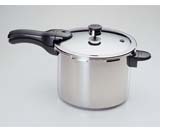 features, many in the “luxury
model” category. The U.S. standard, however, continues to be the weighted
valve regulator (or jiggle top). Virtually all of the products on the market
today adhere to the basic safety and cooking fundamentals of pressure cooking
established by independent testing organizations. In the United States,
the pressure cooker’s popularity continues to quietly resurface because,
no matter what style you choose, it is still the best choice for providing
quick, healthy “real meals,” and so much more.
features, many in the “luxury
model” category. The U.S. standard, however, continues to be the weighted
valve regulator (or jiggle top). Virtually all of the products on the market
today adhere to the basic safety and cooking fundamentals of pressure cooking
established by independent testing organizations. In the United States,
the pressure cooker’s popularity continues to quietly resurface because,
no matter what style you choose, it is still the best choice for providing
quick, healthy “real meals,” and so much more.

Genuine replacement parts for many models of Presto® Pressure Cookers and Pressure Canners.
Genuine Presto parts assure top quality and exact fit.
Click here for Parts
